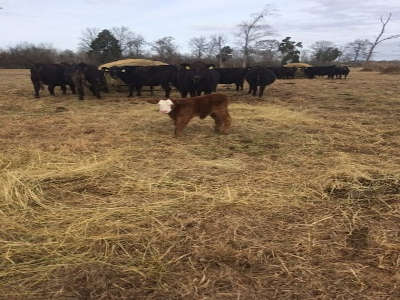By Kim Mullenix
As colder temperatures enter the Southeast, now is a good time to review some practical tips for wintering a beef cattle herd. While many of these strategies are not new, they are noteworthy reminders of best management practices to help keep cattle in good condition through the cooler months of the year.
Understand Changing Nutritional Requirements
Producers must understand that their herd will have changing nutritional requirements because of the animals’ different stages of production. Many beef cattle operations in Alabama calve during the fall or winter, which often coincides with a time of low grazeable forage availability. Energy and protein requirements are the highest during the first 60 days after calving. An appropriate nutritional strategy to maintain cows in good flesh during this time period is especially important, as cows enter into the breeding season around this time window.
Cold Weather Increases Cow Energy Requirements
Additionally, cold weather increases beef cow nutrient requirements. For every degree that the wind chill is below 32°F, a cow’s energy requirement increases by 1 percent. In Alabama, when temperatures drop into the 20 to 30°F range at night, this equals a roughly 7 to 10 percent increase in the energy supply needed to overcome loss from the cold. Under cold, wet conditions this number roughly doubles again.
A good strategy to help overcome energy losses during a cold weather snap is to provide good quality forage and a high-energy supplement (greater than 65 percent TDN) during and for three to five days after the cold weather has subsided. Supplements commonly used in Alabama are soyhulls, corn, a commercial blend with these as the primary ingredients, or whole cottonseed.
Conduct a Forage Analysis
Each county Extension office has a hay probe that can be used to collect forage samples for a basic nutrient analysis through the Auburn University Soil, Forage, and Water Testing Laboratory. A basic analysis includes forage dry matter, total digestible nutrients, crude protein, calcium, and phosphorus values. These measures are used as indicators of hay quality, and can be used to help determine an appropriate feeding strategy for your herd. Contact the Alabama Extension animal sciences and forages regional agent serving your area for help developing a plan for this winter.

Supplement Forages as Needed
Most forages grown in the Southeast tend to be low-to-moderate in quality, with energy being the first most limiting nutrient for beef cattle. This may seem counterintuitive given that many people focus on protein as the most important nutrient for beef herds. However, both are important, and neither can be used effectively in the animal’s diet without the other. Most often, there is a moderate-to-large energy deficit when mature cows are fed low-to-moderate quality warm-season forages like bermudagrass and bahiagrass.
The amount of supplemental energy required to make up this gap is greater for cows during the first 60 days after calving (see Understand Changing Nutritional Requirements above). These cattle would experience more of an energy deficit than a dry, pregnant cow with relatively low nutrient requirements. When forage TDN falls below 50 percent, energy supplementation is needed for all stages of production (dry or lactating). If crude protein of the forage falls below 7 percent, a feedstuff containing a minimum of 12 percent CP is needed to help meet daily requirements.
Think About Winter Management Logistics
Rain and wet conditions often accompany cold weather in Alabama. Producers should select a feeding area that is easily accessible and fairly well-drained. Many producers may have a specific sacrifice area where cattle are fed during the winter to exclude animals from other pastures where winter forages may be establishing. Although mud is inevitable, think about moving the hay feeding location around the sacrifice paddock during the winter to help decrease muddy conditions. Start in the back of the paddock and move hay feeding toward the front over time to decrease heavy traffic continuously over a single area.
Source : aces.edu